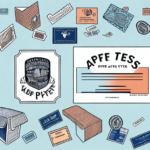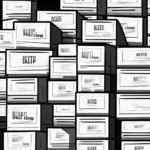Understanding the Dimensions of a Large UPS Box
When shipping large items, selecting the appropriate UPS box is crucial. An improperly sized box can lead to increased shipping costs, damaged shipments, or lost items. Understanding the dimensions and types of large UPS boxes ensures optimal shipping results. This article examines key considerations for selecting a large UPS box and explores various box types available in the market, aiding you in making informed decisions.
Why Size Matters: The Importance of Choosing the Right UPS Box
Choosing the correct UPS box size significantly impacts shipping costs, delivery times, and the safety of your items. A box that's too large results in unnecessary shipping expenses due to excess space, while an undersized box can lead to item damage or loss. According to UPS, optimizing package dimensions can reduce shipping costs by up to 30% (UPS Shipping Guide).
The weight of your items is also a critical factor. Heavy items require boxes that can support their weight without breaking or tearing during transit. For fragile items, considering double-walled boxes or adding extra cushioning is advisable to protect against damage.
Moreover, selecting the right UPS box size contributes to environmental sustainability. Oversized boxes waste space and require more packaging materials, increasing your carbon footprint. Appropriately sized boxes reduce packaging waste and promote eco-friendly shipping practices.
What to Consider When Selecting a Large UPS Box
When selecting a large UPS box, several factors come into play:
- Item Size and Shape: Ensure the box can adequately house and support your items. Measure the length, width, and height to match the box's internal dimensions.
- UPS Shipping Regulations: UPS has specific requirements regarding package size, weight, and shape. Adhering to these regulations prevents penalties and ensures safe transit of your items. Refer to the UPS Shipping Support for detailed guidelines.
- Cushioning and Padding: Appropriate cushioning protects your items from impacts and vibrations during shipping. Materials like bubble wrap, foam, and air pillows are effective.
- Durability: Choose boxes made from sturdy materials, such as double-walled cardboard, to withstand the rigors of shipping and handling.
- Environmental Impact: Opt for boxes made from recycled or eco-friendly materials to minimize environmental impact.
How to Measure the Dimensions of a Large UPS Box Accurately
Accurate measurement of your UPS box is essential to ensure your items fit securely and to comply with UPS regulations. Follow these steps to measure your box accurately:
- Length: Measure the longest side of the box.
- Width: Measure the side perpendicular to the length.
- Height: Measure the vertical distance from the base to the top of the box.
Use a reliable measuring tape or ruler and take measurements to the nearest inch. It's important to measure the internal dimensions to ensure your items fit comfortably inside. For boxes with irregular shapes, take multiple measurements from different angles to capture the true size.
Additionally, consult with UPS for any specific measurement requirements or restrictions related to your shipment to avoid delays or additional fees.
Different Types of Large UPS Boxes and Their Dimensions
UPS offers a variety of box types, each designed to accommodate different shipping needs:
- Telescoping Boxes: Feature adjustable heights with a sliding lid, ideal for items with varying heights such as lamps or vases.
- Adjustable Boxes: Allow customization of box depth through foldable flaps, suitable for irregularly shaped items like electronics.
- Specialty Boxes: Designed for specific items, such as wardrobe boxes for clothing or computer boxes for electronics.
- Reusable Boxes: Built to withstand multiple uses, these boxes are sturdier and come in various sizes.
Each box type has distinct dimensions, so it's advisable to check specifications before selecting a box type. Refer to the UPS Shipping Guidelines for detailed dimensions and suitable uses.
Tips for Packing and Shipping Fragile Items in a Large UPS Box
Shipping fragile items requires meticulous packing to prevent damage during transit. Follow these tips to ensure your items arrive safely:
- Choose the Right Box: Select a sturdy, appropriately sized box to provide a secure fit for your items.
- Use Quality Cushioning: Wrap each fragile item individually with bubble wrap or foam cushioning. Use at least two inches of padding around each item.
- Fill Empty Spaces: Use packing peanuts, air pillows, or crumpled paper to fill any voids, preventing items from shifting.
- Double-Walled Boxes: For extra protection, use double-walled boxes which offer greater strength and durability.
- Seal Securely: Use strong packing tape to seal all edges and seams of the box. Reinforce the bottom and top for added protection.
- Label Clearly: Mark the box as 'Fragile' to alert handlers to take extra care during shipping.
Test the box's strength by gently shaking it to ensure items remain secure. Proper packing not only protects your items but also minimizes the risk of return due to damage.
Maximize Storage Space with Custom-Sized UPS Boxes
Custom-sized UPS boxes offer tailored solutions to maximize storage space and optimize shipping costs. By customizing box dimensions to fit your items precisely, you eliminate unnecessary void spaces that increase shipping expenses. Benefits of custom-sized boxes include:
- Cost Efficiency: Reduced shipping costs by minimizing the use of excess packaging materials.
- Enhanced Protection: Custom dimensions ensure items are snugly fitted, reducing movement and potential damage during transit.
- Professional Appearance: Custom packaging presents a professional image, enhancing customer satisfaction.
While custom-sized boxes may have a higher upfront cost compared to standard boxes, the long-term savings on shipping costs and improved item protection can offset the initial investment. Consider your shipping volume and item diversity when deciding on custom versus standard box sizes.
How to Save Money on Shipping Costs with the Right-Size UPS Box
Optimizing box size is a straightforward strategy to reduce shipping costs. Here’s how the right-size UPS box can save you money:
- Minimize Dimensional Weight: UPS calculates shipping costs based on dimensional weight or actual weight, whichever is greater. Using appropriately sized boxes reduces dimensional weight charges.
- Reduce Packaging Materials: Smaller boxes require fewer cushioning materials, lowering packaging costs.
- Lower Fuel Surcharges: Efficient packaging can lead to more packages per shipment, potentially reducing fuel surcharges.
- Avoid Oversize Fees: Staying within UPS size guidelines prevents additional fees associated with oversized packages.
To further reduce costs, consider using flat-rate boxes for heavier items, leveraging volume discounts, and consolidating shipments when possible. Regularly assess your packaging strategy to ensure continued cost efficiency.
Understanding Weight Limits for Large UPS Boxes
UPS imposes weight limits based on the size and type of the box. Understanding these limits is essential to avoid additional fees and ensure safe delivery. Key weight guidelines include:
- Standard Boxes: Typically support up to 70 pounds.
- Specialty Boxes: May have higher weight capacities, depending on construction and design.
- Overweight Packages: Packages exceeding the weight limit incur additional charges and may require special handling.
Always verify the weight capacity of your chosen box and ensure your shipment complies with UPS guidelines. Utilize scales for accurate weight measurement and consider reinforcing boxes for heavier items.
Protect Your Shipment with Proper Cushioning and Padding Techniques
Effective cushioning and padding are vital for protecting your items during shipping. Implement the following techniques to safeguard your shipments:
- Use Multiple Layers: Apply at least two layers of cushioning materials around each item.
- Secure Inside the Box: Ensure items are immobilized within the box to prevent movement.
- Protect Corners and Edges: Reinforce vulnerable areas with additional padding.
- Choose the Right Materials: Utilize bubble wrap, foam inserts, or air pillows based on item fragility.
- Double Boxing: For extremely fragile items, consider placing the item in one box and then placing that box inside a second box with additional padding.
Proper cushioning not only protects items but also reduces the likelihood of returns due to damage, enhancing customer satisfaction and reducing costs.
How to Choose the Right Material for Your Large UPS Box
The material of your UPS box plays a crucial role in protecting your items and ensuring safe delivery. Consider the following materials when selecting a box:
- Corrugated Cardboard: Widely used due to its strength and affordability. Double or triple-walled corrugated boxes offer enhanced durability.
- Plastic Containers: Provide excellent protection against moisture and harsh handling. Ideal for reusable shipping needs.
- Recycled Materials: Eco-friendly options made from recycled cardboard or bio-based plastics reduce environmental impact.
- Insulated Boxes: Suitable for temperature-sensitive items, providing thermal protection during transit.
Selecting the appropriate material depends on the item's weight, fragility, value, and the shipping environment. For high-value or fragile items, investing in higher-grade materials can prevent costly damages.
Avoiding Common Mistakes When Buying or Using a Large UPS Box
To ensure efficient and safe shipping, avoid the following common mistakes when selecting and using large UPS boxes:
- Incorrect Sizing: Using boxes that are too large or too small leads to increased costs and higher risk of damage.
- Poor Quality Packaging: Substandard boxes can break or tear, compromising the safety of your items.
- Inadequate Cushioning: Insufficient padding results in items moving and colliding inside the box.
- Ignoring Weight Limits: Overloading boxes exceeds UPS weight limits, leading to additional fees and potential handling issues.
- Improper Sealing: Weakly sealed boxes can open during transit, exposing items to damage.
By addressing these common issues, you can enhance the efficiency of your shipping process, protect your items, and reduce overall shipping costs.
Conclusion
Choosing the right dimensions for your large UPS box is essential for ensuring that your items arrive safely and cost-effectively. By understanding the different types of boxes available, accurately measuring dimensions, selecting appropriate materials, and employing proper packing techniques, you can optimize your shipping strategy. Additionally, being aware of UPS weight limits and avoiding common packaging mistakes further enhances the efficiency and safety of your shipments. Implementing these best practices not only safeguards your items but also contributes to cost savings and sustainable shipping efforts.






















